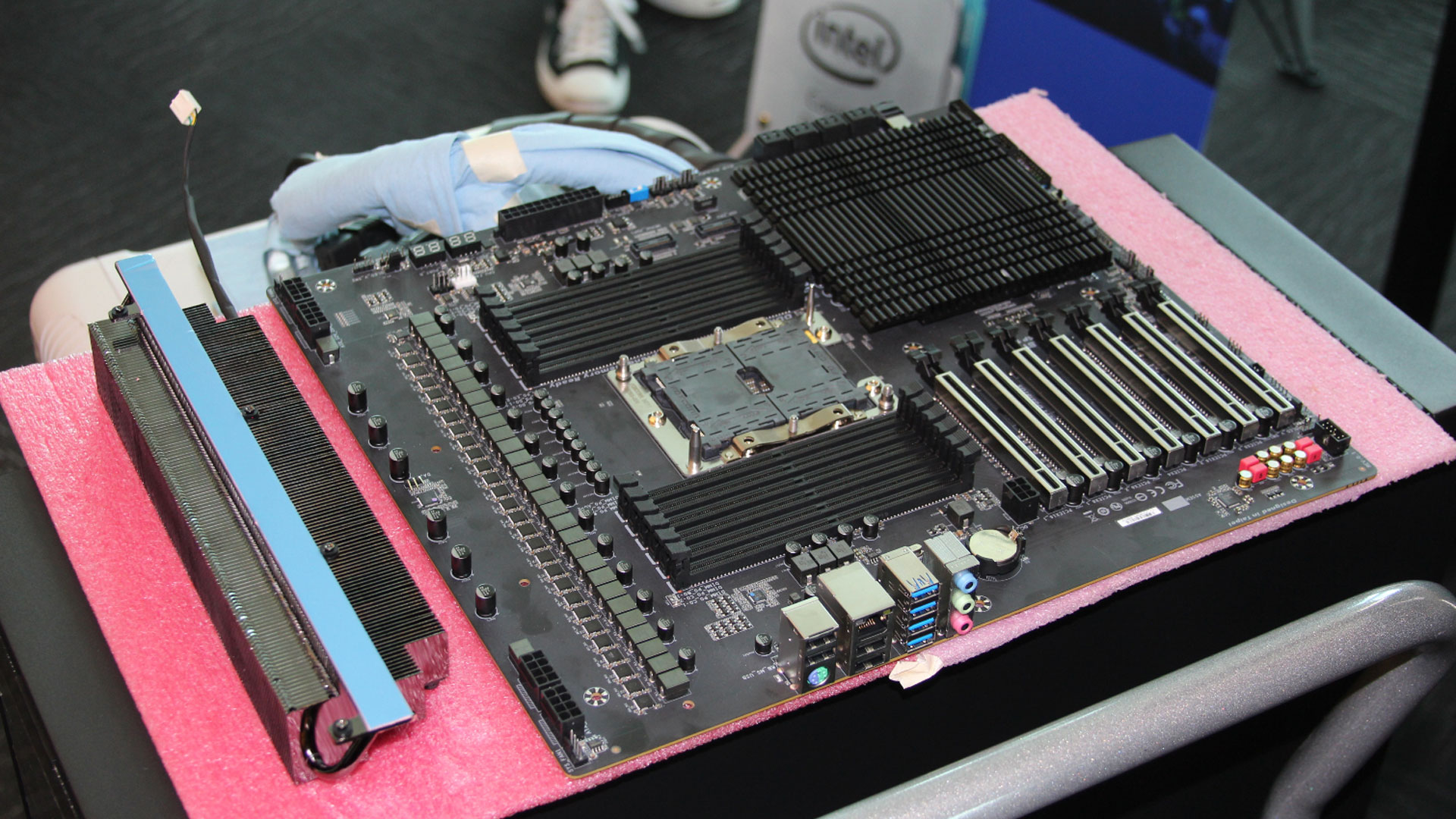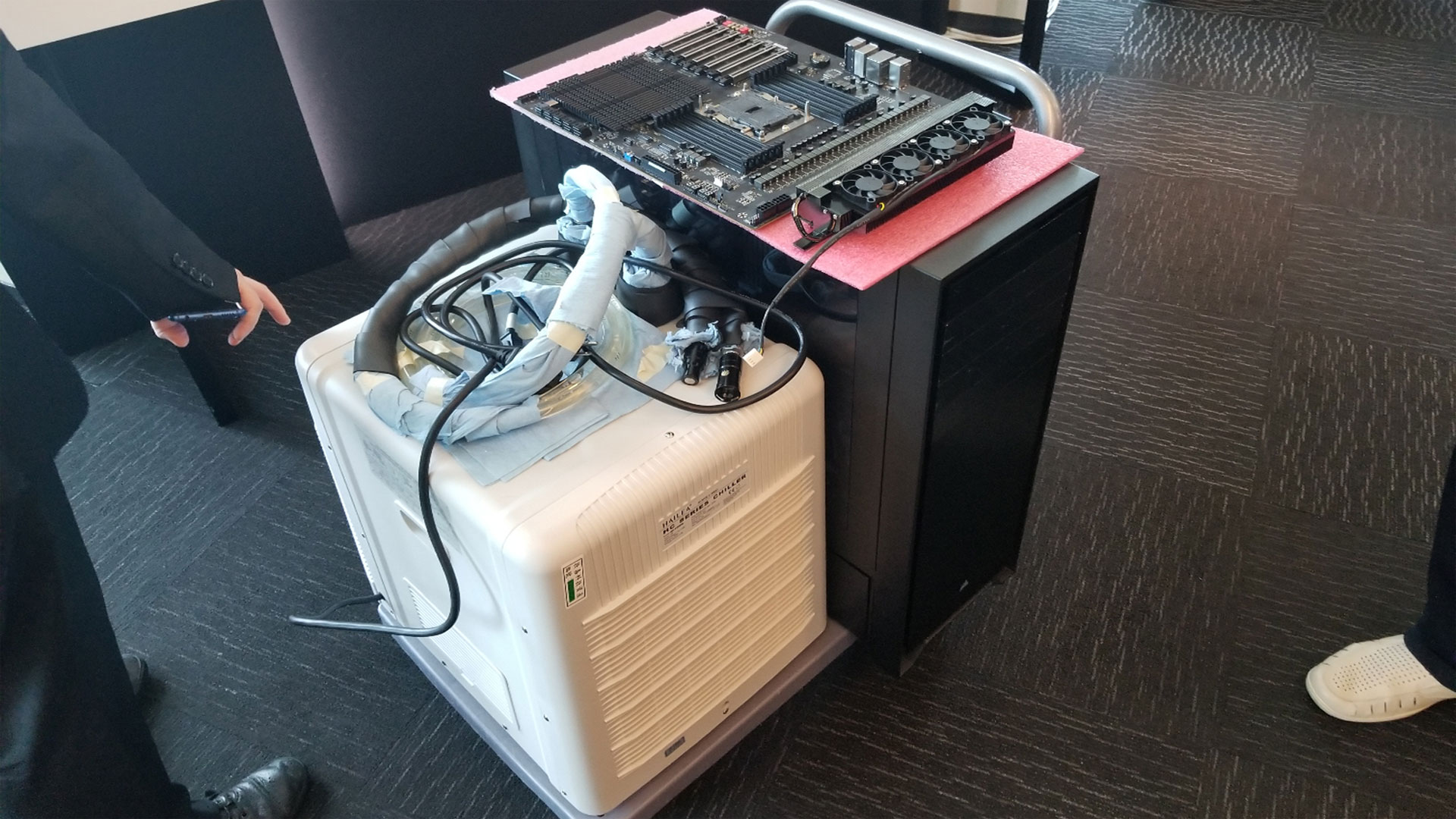A closer look at Intel's 5GHz 28-core CPU
You're never going to see air-cooled overclocks at this level.

Earlier this week, Wes wrote up Intel's demonstration of a future 28-core enthusiast CPU that should launch later this year. There was nothing particularly shocking about the reveal, considering Intel already has 28-core Xeon Platinum chips. Except, the mere fact that Intel is demonstrating an enthusiast targeted CPU using its biggest and best Xeon die should raise an eyebrow or two in the first place.
These parts normally go into the biggest and most expensive servers around, and the least expensive option currently listed on Intel's CPU database is the Xeon Platinum 8176, with a price of $8,719. As a point of reference, the Xeon Gold 6140 is the server equivalent of the Core i9-7980XE, and it's priced at $2,445 compared to only $1,999 for the consumer part. Even if Intel cuts the price of the Xeon 8176 in half, we're still potentially talking about a $4,000 processor. In other words, this CPU isn't going to show up in your next build unless you happen to be extremely well connected.

But let's forget about the price for a moment and talk about performance. Intel showed the 28-core chip running at 5.0GHz, with all 28 cores and 56 threads loaded. What it didn't show or mention at the time was the cooling system required for such performance, or the power draw.
More details have come to light since the initial demonstration, but in case you weren't aware, this is not the first time Intel has demonstrated heavily overclocked CPUs prior to launching new chips. We mistakenly said that the CPU would run at up to 5.0GHz, but we don't really know the Turbo Boost clockspeeds, base clocks, or anything else. And I can assure you that 28 cores won't run at speeds north of 4.0GHz without substantial cooling.
My reasoning is simple: even the 10-core Core i9-7900X sucks down a lot of power at 4.0GHz, and in AVX workloads I've seen that chip use well north of 350W of power. The 18-core Core i9-7980XE takes it a step further, and at 4.0GHz with AVX clocks knocked down to 3.6GHz, it can pull over 400W. And depending on your motherboard and power supply, trying to draw more power than that will often result in a hard reset of the system. It's happened to me many times during testing, with all the Core i9 processors, and temperatures with a maxed out Corsair H115i cooler can easily get above 90C.
So what does it take to hit 5.0GHz on a 28-core Skylake-X CPU? Try this on for size:

Okay, Intel isn't using LN2 (liquid nitrogen), but that's a massive refrigerated liquid cooling loop clearly designed to take the CPU below ambient, probably close to the freezing temperature range. (I've read elsewhere that it can go as low as 4C.) The insulation around the tubing is necessary to prevent condensation when running such temperatures. Tom's Hardware has images showing the specific model is the Hailea HC-1000B, with a 1HP motor that chills the refrigerant and allows dissipating up to 1000W of power. Based on my experience with the existing Core i9 parts, that's exactly what you'll need to do to cope with a 28-core Skylake-X chip running at 5GHz.
The biggest gaming news, reviews and hardware deals
Keep up to date with the most important stories and the best deals, as picked by the PC Gamer team.
The fallout from Intel's 28-core enthusiast CPU demonstration has been interesting, but this was a publicity stunt and not something most users will ever run. With or without the refrigerator, the number of people in the market for a 28-core CPU has to be extremely limited, considering the price for just the CPU is likely to be several thousand dollars. The Gigabyte LGA3647 motherboard used in the demonstration is also extreme, with a 32-phase power delivery system that requires another massive heatsink with four small fans, and the four separate EPS12V connectors.
I'm not aware of any PSUs that have four EPS12V connections, even high-end 1200W models typically only have two, which means in addition to the Hailea cooler you're looking at running a pair of high wattage PSUs. Combined, the cooler and overclocked CPU are likely drawing at least 2000W, enough to max out a standard 15 Amp circuit in the US. And naturally the result is blisteringly fast.
We're bringing heavy metal computing with the 24-core @AMDRyzen #Threadripper! #Computex pic.twitter.com/DyhW9Vg4R4June 6, 2018
AMD's 32-core Threadripper response isn't quite as crazy in terms of cooling and clockspeeds, though the above Tweet from AMD appears to show that the initial Computex plans were to demonstrate and announce a 24-core Threadripper. Depending on how big your cooler is, 4.0GHz on all 32 cores might be possible, as that would be around 300W.
That's a far cry from whatever power Intel's chip is pulling, but I also don't expect the next Threadripper parts to overclock much beyond 4.2-4.3GHz, and stock clocks for all 32 cores being utilized well be much lower.
The battle of the cores is well and truly underway, and if you've ever wanted to run the biggest and baddest server CPUs in a consumer PC—and then overclock them—you'll be able to do so later this year.
I don't need 32 cores or even 28 cores, but damned if I don't want them.
Jarred's love of computers dates back to the dark ages when his dad brought home a DOS 2.3 PC and he left his C-64 behind. He eventually built his first custom PC in 1990 with a 286 12MHz, only to discover it was already woefully outdated when Wing Commander was released a few months later. He holds a BS in Computer Science from Brigham Young University and has been working as a tech journalist since 2004, writing for AnandTech, Maximum PC, and PC Gamer. From the first S3 Virge '3D decelerators' to today's GPUs, Jarred keeps up with all the latest graphics trends and is the one to ask about game performance.


